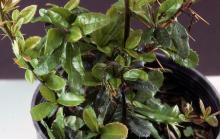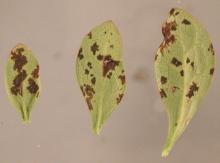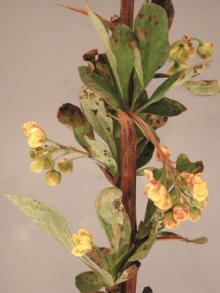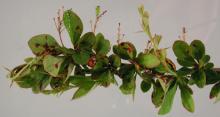Cause Pseudomonas syringae pv. berberidis, a bacterium. The disease is favored by cool, wet weather in spring. Although the bacteria survive on the outside of the plant they must get inside and multiply in the space between plant cells (apoplast) to cause disease. These pathogenic bacteria inject several proteins and small-molecule toxins to get past host immune mechanisms. Once inside, the bacteria induce a watery, nutrient rich environment between the plant cells where they can multiply and continue colonization of the plant tissues. Bacteria also produce a protein that acts as an ice nucleus, increasing frost wounds that bacteria easily colonize and expand.
Symptoms Lesions first appear water-soaked, becoming very dark brown or black. Chlorotic halos usually are present. Leaves may fall prematurely, and lesions may occur on petioles and succulent twigs.
Cultural control
- Keep foliage dry.
- Protect from winter injury.
Chemical control Fall and spring applications, used for other crops, may be effective on barberry. Fixed-copper products (Group M1 fungicides) may be helpful. Bacteria resistant to copper products have been detected in many nurseries. Limit the use of any one group during crop production.
- Agri-Mycin 50 at 5.3 to 16 oz/100 to 300 gal water/A. Tolerant strains of the bacterium easily develop with repeated use of this product. Alternate with other bactericides to prevent or delay buildup of tolerant strains. Group 25 fungicide. 12-hr reentry.
- FireWall 50 WP at 1.36 oz/25 gal water. Group 25 fungicide. 12-hr reentry.
- Junction at 1.5 to 3.5 lb/A. Useful against copper-resistant bacteria. Group M1 + M3 fungicide. 48-hr reentry.
- Nu-Cop 50 DF at 1 lb/100 gal water. Not specifically registered on barberry so use on a few test plants and observe for phytotoxicity before general use. 48-hr reentry. O
- Phyton 27 at 1.5 to 3.5 fl oz/10 gal water. 48-hr reentry.
References Bradbury, J.F. 1986. Guide to Plant Pathogenic Bacteria. CAB International Mycological Institute.
Roberts, S.J., and Preece, T.F. 1984. A note on Pseudomonas syringae pv. berberidis infections of Berberis: aetiology of a leaf spot and leaf fall disease in England. Journal of applied bacteriology 56:507-513.





